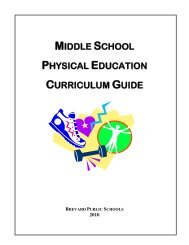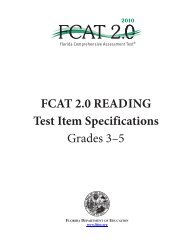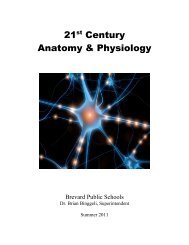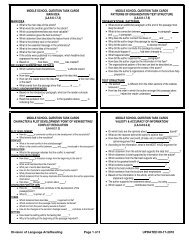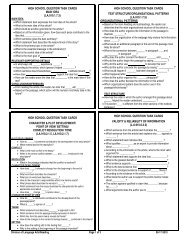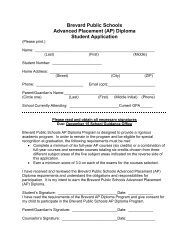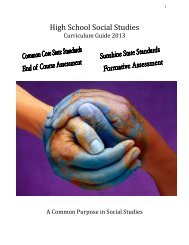Science Research Program Guide - Secondary Programs Home ...
Science Research Program Guide - Secondary Programs Home ...
Science Research Program Guide - Secondary Programs Home ...
You also want an ePaper? Increase the reach of your titles
YUMPU automatically turns print PDFs into web optimized ePapers that Google loves.
questions related to personal experiences such as sexual,<br />
physical or child abuse, divorce and/or psychological<br />
well-being (e.g. depression, anxiety, suicide) must be<br />
considered more than minimal risk. Additionally, research<br />
activities that involve exposing subjects to stimuli or<br />
experimental conditions that could potentially result in<br />
emotional stress must also be considered more than<br />
minimal risk. Examples include violent or distressing video<br />
images, distressing written materials or activities that<br />
could potentially result in feelings of depression, anxiety,<br />
or low self-esteem in subjects.<br />
b. Any activity that could potentially result in negative<br />
consequences for the subject due to invasion of privacy or<br />
breech of confidentiality. Confidentiality involves taking<br />
careful measures to ensure that the research data and/or<br />
responses are not disclosed to the public or unauthorized<br />
individuals with identifiable information. When research<br />
activities involve collection of personal information (e.g.<br />
history of abuse, drug use, opinions, fingerprints) or<br />
health-related data (genetic material, blood, tissue) the<br />
researcher must consider risks related to invasion of<br />
privacy and possible breech of confidentiality. Ways to<br />
reduce these risks include collecting data anonymously or<br />
developing data collection procedures that make it<br />
impossible to link any identifying information (e.g.<br />
subject’s name) with his/her responses or data.<br />
Anonymity involves collecting research data in such a<br />
way that it is impossible to connect research data (e.g.<br />
responses, questionnaires) with the individual who<br />
provided the data. That is, personal identifiers (e.g.<br />
names, birthdates, social security numbers) are not<br />
collected or linked with the data.<br />
Informed Consent<br />
The process of obtaining informed consent provides<br />
information to the subject (and where applicable, parents or<br />
guardians) about the risks and benefits associated with<br />
participation in the research study and allows the subject (and<br />
where applicable, parents or guardians) to make an educated<br />
decision about whether or not to participate. Informed consent<br />
is an on-going process, not a single event that ends with a<br />
signature on a page. It must incorporate procedures that do<br />
not involve coercion or deception.<br />
Section A. Informed Consent Required<br />
Documentation of informed consent is required for the<br />
following as long as the study does not meet any of the criteria<br />
for a waiver as described in Section B.:<br />
1) When the IRB determines that a research study involves<br />
physical or psychological activities with more than<br />
minimal risk.<br />
2) When the IRB determines that the project could<br />
potentially result in emotional stress to a research<br />
subject.<br />
3) When the IRB determines that the research subjects<br />
belong to a risk group and the study does not meet any<br />
of the criteria below for a waiver.<br />
Section B. Informed Consent May Be Waived<br />
The IRB may waive the requirement for documentation of<br />
written informed consent if the research involves only<br />
minimal risk and anonymous data collection and if it is one<br />
of the following:<br />
a) <strong>Research</strong> involving normal educational practices<br />
b) <strong>Research</strong> on individual or group behavior or<br />
characteristics of individuals where the researcher does<br />
not manipulate the subjects’ behavior and the study<br />
does not involve more than minimal risk.<br />
c) Surveys and questionnaires that are determined by the<br />
IRB to involve perception, cognition, or game theory<br />
and do NOT involve gathering personal information,<br />
invasion of privacy or potential for emotional distress. If<br />
there is any uncertainty regarding the appropriateness<br />
of waiving informed consent, it is strongly recommended<br />
that informed consent be obtained.<br />
d) Studies involving physical activity where the IRB<br />
determines that no more than minimal risk exists and<br />
where the probability and magnitude of harm or<br />
discomfort anticipated in the research are not greater<br />
than those ordinarily encountered in DAILY LIFE or<br />
during performance of routine physical activities.<br />
If the documentation of informed consent is not required or<br />
obtained, all subjects must still give their consent/assent to<br />
participate in the study. <strong>Research</strong> subjects under 18 years of<br />
age or other individuals not able to give consent (e.g. mentally<br />
disabled) give their assent, whereas adults give their consent.<br />
The researcher must inform potential subjects about the<br />
purpose of the study and what they will be asked to do. The<br />
potential subjects must also be informed that their<br />
participation is voluntary and that they may withdraw from the<br />
study at any time. This information and the consent/assent<br />
can be either verbal or written. The procedure for obtaining<br />
consent/assent should be included in the research plan.<br />
If a research subject is under 18 years of age, it is<br />
recommended that informed consent be obtained. Both the<br />
parent/legal guardian and the school age research subject<br />
must sign Human Subjects Form (4). However, an IRB may<br />
decide that informed consent is not required because of the<br />
allowable exceptions listed above. When the IRB waives<br />
informed consent of research subjects under the age of 18<br />
for studies involving surveys or questionnaires, justification<br />
of this waiver must be stated on Human Subjects Form (4).<br />
Review Process<br />
1) A student interested in doing a human subjects research<br />
project must first review the rules, choose a study group<br />
and consider the risks of their proposed research. The<br />
student must work with their Adult Sponsor who can guide<br />
them to a Qualified Scientist, if necessary, to help in the<br />
development of their research plan.<br />
International Rules for Precollege <strong>Science</strong> <strong>Research</strong>: <strong>Guide</strong>lines for <strong>Science</strong> and Engineering Fairs / 2008-2009 Page 15



